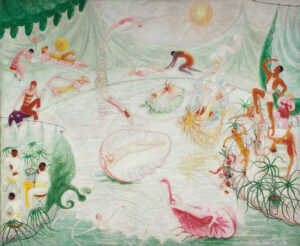Today’s post comes from Michael Reback, Vassar College class of 2011 and Art Center student docent.
When I first arrived at Vassar College in the fall of 2007, the Maria Mitchell Observatory looked quite a bit different. Though it has since been refurbished, the building struck me as a beautiful ruin — its metal dome, now revealed to be shiny tin, was rusted a deep turquoise color. For the final installment of the Insights on Site lecture series, Colton Johnson, Dean Emeritus of the College and Professor Emeritus of English, divulged some of the history of Maria Mitchell and the building that bears her name. Also known as the Old Observatory, it was the first building on the Vassar campus, and in 1991, it was recognized as a National Historic Landmark.

Maria Mitchell (1818-1889) was born into a Quaker family on Nantucket. Her father worked in several different professions, but his lifelong passion was astronomy, and Mitchell would often stargaze with her father. She, too, became passionate about astronomy, and in 1847, she discovered a “telescopic” comet. This discovery earned her a gold medal from the King of Denmark, who had offered a prize to the first person to spot a comet not visible to the naked eye, and also garnered Mitchell international scientific recognition. Thus, Maria Mitchell was a prime candidate when Matthew Vassar was assembling the college’s original faculty.
Mitchell, however, struck a hard bargain. She demanded the observatory include a residence for her and her father — and although the teaching and astronomical facilities were among the best in the country, she was a bit disappointed in the living quarters. Maria wrote several letters to college officials expressing a desire to have the basement residence improved, but she continued living there through her last year of teaching. But her students were more than willing to trek from Main to the Observatory; aside from teaching astronomy, Mitchell also hosted “dome parties” under the building’s dome.
Entering the dome room now, it is drastically different from the original space: the room still serves as a classroom, but the original telescope which once occupied the room is now at the Smithsonian in Washington, D.C. Luckily, one room over, an original artifact remains in place. The Observatory Clock, which occupies what was once the
“Clock and Chronograph Room,” is an astronomical clock that was used to obtain accurate readings of time for recording sightings. The clock still runs, though the time is currently a bit off, and stands tall as a lovely reminder of the way the Old Observatory once functioned.

On the outside of the building, up the main stairs and in a small niche, a bust of Maria Mitchell stares out from the observatory. Although the building has changed drastically over the last 150 years, the sculpture makes me feel as if Maria is still there — staring out upon Vassar, the school she helped define, hopeful and inquisitive. It’s as if she’s still staring out into the endless possibilities of space itself.




